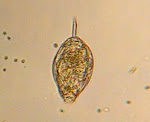Monday, November 17, 2008
Week 4
In week 4 of the observation of the microaquarium life has once again changed. Many of the organisms inside the aquarium have began to die off leaving many remains behind. All the dead remains seemed to all settle at the bottom with the initial sediment. Most of the organisms alive are larger and more predatorial besides the long chains of cyanobacteria which are photosynthetic. The larger organims are many shelled rotifers swimming around and i witnessed one organism I had not witnessed before was an ostracod (Pond II Larger Microlife 1998 Gordon Peachey, Canada). The more I observed the microaquarium, the more it changed.
Monday, November 10, 2008
Week 3
In the third week of observation life has changed again inside the microaquarium. Many organisms witnessed in the first two weeks of observation have died and their remains were left behind. The diversity of organisms has changed and one particular organism that is thriving is the amoeba (Pond I Smaller Microlife 1998 Gordon Peachey, Canada). Another organism that is thriving in great numbers is the shelled rotifer (Pond I Smaller Microlife 1998 Gordon Peachey, Canada). Many green photosynthetic organisms are thriving inside the aquarium. Also one particular green algae is thriving and this organism is known as spirogyra (Pond III Photosynthetic Microlife Gordon Peachey, Canada).
Sunday, November 2, 2008
Difflugia Spotted 10/30/08
My last observation of the Microaquarium was quite different than my most recent observation. The life inside the enviroment has changed quite dramatically because the size and number of organisms has greatly increased. The dramatic change of the enviroment can be atrributed to the addition of protein to the enviroment causing a dramatic increase of the supply of available food. The increase of food has caused many organisms to increase in size because they are able to eat and to increase in number for the same reason. New organisms have appeared and one organism in particular that caught my eye is one called a difflugia. The difflugia has an appearance of a snail and I correctly identified it from the poster Pond II Larger Microlife (Gordon Peachey 1998). The difflugia is an amoeba and is interesting because it has shell and I also witnessed this organism consuming others with its appendages. I correctly identified this organisms features from The Liveng Freshwater Protozoa: A Color Guide by D.J. Patterson of The University of Bristol.
Subscribe to:
Comments (Atom)

